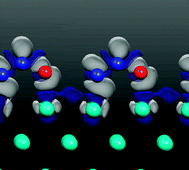Adsorption of N2O on Cu(100): a combined scanning tunneling microscopy and density functional theory study
Abstract
The

* Corresponding authors
a
Institut für Experimentalphysik, Freie Universität Berlin, Arnimallee 14, Berlin, Germany
E-mail:
franke@physik.fu-berlin.de
b LCAR (UMR 5589), Université Paul Sabatier, 118 route de Narbonne, Toulouse, Cédex France
c Centro de Investigación en Nanociencia y Nanotecnologia, CSIC-ICN, Campus de la UAB, Bellaterra, Spain
The

 Please wait while we load your content...
Something went wrong. Try again?
Please wait while we load your content...
Something went wrong. Try again?
K. J. Franke, I. Fernández-Torrente, J. I. Pascual and N. Lorente, Phys. Chem. Chem. Phys., 2008, 10, 1640 DOI: 10.1039/B716952C
To request permission to reproduce material from this article, please go to the Copyright Clearance Center request page.
If you are an author contributing to an RSC publication, you do not need to request permission provided correct acknowledgement is given.
If you are the author of this article, you do not need to request permission to reproduce figures and diagrams provided correct acknowledgement is given. If you want to reproduce the whole article in a third-party publication (excluding your thesis/dissertation for which permission is not required) please go to the Copyright Clearance Center request page.
Read more about how to correctly acknowledge RSC content.
 Fetching data from CrossRef.
Fetching data from CrossRef.
This may take some time to load.
Loading related content
